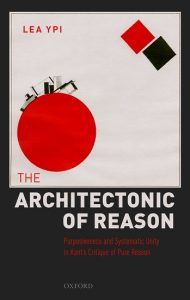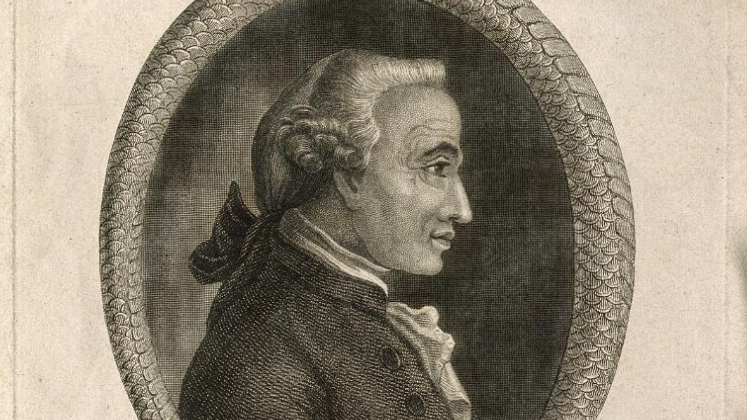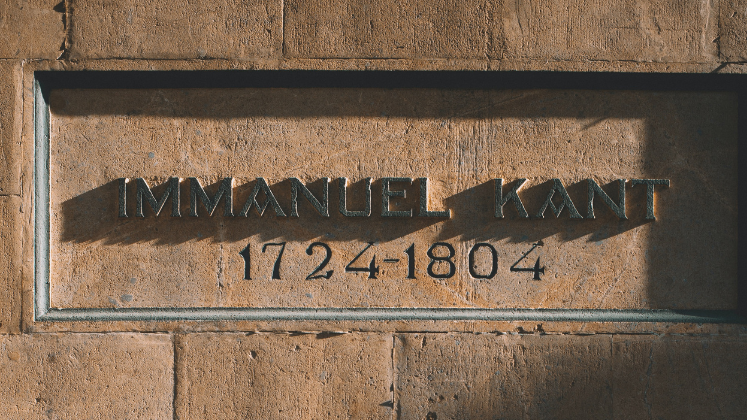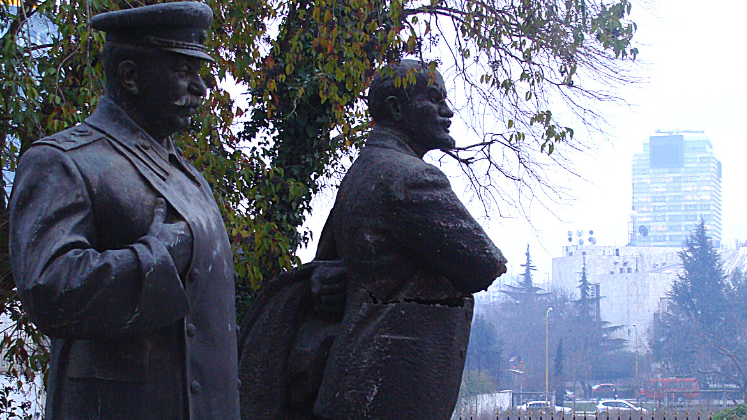In The Architectonic of Reason: Purposiveness and Systematic Unity in Kant’s Critique of Pure Reason, Lea Ypi explores the importance of this crucial section of Kant’s first Critique, showing its significance to the development of the German philosophical tradition. This penetrating analysis of Kant’s Architectonic should shape future discussions of Kantian scholarship, writes Jake Scott.
The Architectonic of Reason: Purposiveness and Systematic Unity in Kant’s Critique of Pure Reason. Lea Ypi. Oxford University Press. 2021.
 Find this book (affiliate link):
Find this book (affiliate link):![]()
On page 100 of Lea Ypi’s The Architectonic of Reason, we find a quote that could well summarise her entire enterprise: ‘Kant’s argument here is strong and, at the same time, problematic.’ Whilst it is an understatement to say that the figure of Immanuel Kant dominates the study of philosophy, interpretations of his work remain deeply contested. The noumenal-phenomenal problem – in which Kant creates an ‘unbridgeable gap’ between the world as it really is (the noumenal) and the world as we perceive it (the phenomenal) – means that, for many empiricists, Kant’s works fail in their core objective to concretely ground epistemic knowledge.
It is with this in mind that Ypi takes on one of the most ‘densest, obscure, and at times outright impenetrable texts in Kant’s entire body of published work’ (1) – the Architectonic of Pure Reason, found in Chapter III of the Transcendental Doctrine of Method of the Critique of Pure Reason. In the introduction Ypi shows not just the importance of this part of Kant’s work, but also its relevance to the subsequent development of German idealism. She does what many authors completely neglect – valuing a work for its failure, not in spite of it.
The first few pages of The Architectonic of Reason offer the logic behind the book and its central goal in an exceedingly clear introduction. The first line is particularly intriguing: ‘this book […] tries to explain why the unity of reason is necessary, how Kant defends it, and why the project fails’. With the rest of the introduction laying out Ypi’s method for understanding this obscure part of Kant’s work, there are immediate hints of a Derridean style: ‘Here, rather than the aspiration to demolish a certain kind of building in order to replace it with one that appears more adequate, […] the task of critical philosophy is to merely offer a survey of the foundation work. There is no hint of a ‘‘new plan’’: the constructive enthusiasm of reason is restrained by an appeal to limit the project to its critical part’ (8).
Subsequently contextualising the Architectonic in Kant’s own works, Ypi turns to critique the contemporary literature on this dense section, before returning to the wider intellectual context of the Enlightenment to demonstrate why it matters so much. At the close of the introduction the reader cannot help but be struck by the fact that Ypi is clearly an excellent teacher of Kant, as well as student.

Image Credit: Crop of Immanuel Kant. Stipple engraving by J. Chapman, 1812. Wellcome Collection. Public Domain Mark.
Chapter One opens with a thorough survey of the material on Kant’s Architectonic, before displaying the historical prevalence of a ‘unity of the system’ to the scholastics, and Kant’s role and place in the move away from that school of thought. The tradition of the ‘unity of the system’ is one that attempts to prove the necessity of relating all knowledge together, rather than bracketing ‘fields’ of knowledge into discrete ‘areas’ (such as science, language and so on). Ypi contextualises Kant’s works in the study of German philosophy in general, and idealism in particular, especially in reference to scholastic debate and decline in the eighteenth century (20-22).
Moving to examine Kant’s idea of practical reason and how that relates to his systematic unity, Ypi’s clear and rich understanding allows her to explain how Kant departed from scholasticism as part of the move to a cosmic philosophy, whilst also retaining a distinct and identifiable strand that remains ‘his’. The subsequent section explains why unity becomes Kant’s primary concern in his philosophy, and how the three questions – ‘What can I know? What should I do? What may I hope?’ – lead to the fourth, most important, question: ‘Was ist der Mensch?’ (what does it mean to be a person?) (26).
Though Ypi’s book is at times difficult to fully comprehend, this is due to the subject matter. Whilst Kant is dense and at times incoherent – as Ypi is at pains to show in later chapters – there are moments of absolute clarity that pepper her work, assisting the reader in understanding not only her own argument, but that of Kant. One example appears on page 34: ‘for Kant it is essential to think of reason as a unitary systematic whole in which the ‘‘gulf’’ between natural necessity and moral freedom is filled with the help of the principle of purposiveness. The idea of a moral whole to which we have access through the practical use of reason is helpful to provide a transcendental foundation to the assumption of systematic unity necessary to connect general principles with particular manifestations of natural regularities.’
Chapter Two is the part in which Ypi grasps the subject at hand, analysing the use of the phrase ‘architectonic’ in Kant’s first Critique and its prevalence, and why Kant gravitated to it as a descriptor for his own project of systematic unity. This is followed by an examination of how Kant used it, especially in the context of his influences and interlocutors.
Again, Ypi’s incredible scholarship helps her to challenge and overcome the limits imposed by others’ limited reading of the Architectonic. Ypi moves from citing Kant from across his career, including more obscure essays and even lecture notes, to commenting on the secondary literature that surrounds and shapes contemporary understandings of Kant in detailed footnotes (43). This allows Ypi to carefully and expertly pull apart Kant’s inconsistent use of terms to show the muddying of his otherwise penetrating analysis.
This is not to say that Ypi’s own analysis is without problems. In a run of about five pages, Ypi identifies at least three issues to which she promises to return later. Whilst she does so, the analysis feels at times more like a deferral and organisationally muddled. This is largely due to the complexity of the work at hand, but it still feels difficult to follow.
Having established the role of the Architectonic, in Chapter Three Ypi delves into scholarship on the Architectonic and the three Critiques more generally, whilst simultaneously bracketing it off to ensure it does not distort her own highly original interpretation. One example is on page 61, in which Ypi addresses the confusion arising from Kant’s movement from architectural to organic metaphor. While this puzzles many commentators, Ypi shows that it is simpler and more consistent than one might first presume. Ypi draws out Kant’s own understanding of architecture as ‘a form of art where the principle of purposiveness is also essential in thinking about the connection between the whole and the parts’, using this to illustrate that the supposed dichotomy between construct and organism is, to the Kantian, a false one.
Even in criticising the Architectonic, Ypi never fails to respect the sophistication Kant displays. As an example of Kant’s systematicity, Ypi writes that ‘every particular body of knowledge occupies a specific place in the history of philosophy’ (75). This reminds the reader of the importance of comprehending the Architectonic as the key part of Kant’s analysis of that systematic unity, even in the midst of criticism.
Moving on to this critical part of her work, in Chapter Four Ypi undertakes a careful dissection of Kant’s contradictory statements in the Critique of Pure Reason. Ypi seeks to rectify this through ‘the reference to the ideas of reason’, and in remembering that ‘the idea of systematic unity is logically necessary and not a mere addition to the synthesis of the understanding as the less demanding interpretations of the speculative role of ideas usually maintain’ (90, my emphasis).

Image Credit: Photo by Egor Myznik on Unsplash
A recurrent theme in Ypi’s book is her familiarity not just with Kant’s works, but the historiography and scholarship surrounding it. Chapter Five is exemplary of this approach: in discussing the deduction of transcendental ideas in the first Critique, Ypi reveals the glaring error in scholarly attempts to resolve the issue. Many scholars presume the presence, yet are plagued by the absence, of a categorical imperative. This was famously introduced in the Groundwork but would not find so clear an expression until the Metaphysics of Morals, published nearly 20 years later. As Ypi writes, ‘if practical reason has no autonomous domain of its own and makes no practical laws that it imposes on the world, appealing to the later doctrine of the categorical imperative or transcendental freedom to solve the tensions present in these pages is unlikely to help clear the ambiguous status of ideas’ (108).
Yet, as Ypi shows, Kant’s own writings do oscillate too much on the role of ideas, and then – in an attempt to resolve that tension – between purposiveness as normativity and purposiveness as design, to provide an authoritative answer. Ypi also shows that Kant transitions between the Critiques from a natural teleology to a physico-theological standpoint, writing that ‘the coherence of reason demands a coherent structure of the universe and we can only make sense of this coherent structure with reference to an intelligent being at the source of it’ (118).
This opens the way to a final explanation of Ypi’s pronouncement made in the opening lines: why Kant’s project to show the unity of reason ultimately fails. Eventually, for Ypi, Kant’s attempt to resolve tensions, only to create another tension, results in collapsing the distinction between nature as purpose and the purposeful design of nature (what we would now call ‘intelligent design’). It is in the final two chapters that Ypi begins to really expose the tensions in Kant’s philosophy, such as between practical and transcendental freedom (and its subsequent reliance on God) (142) and the order of nature and the order of moral ends (160).
After a thoroughgoing analysis of the Architectonic, its role in Kant’s thought and its relation to his understanding and theorisation of ideas and the unity of the system, Ypi writes that ‘we are now finally in a position to understand the meaning of Kant’s assertion in the Architectonic that the idea of the whole, necessary to the organic unity of the system, is schematised through the essential ends of reason’ (166). Ultimately, as Ypi shows in the book’s conclusion, the vindication of the Architectonic is found in Kant’s subsequent works, not in the internal coherence of the Architectonic itself: ‘the principle of purposiveness that is at the heart of the Architectonic of Pure Reason produces a tension between critical commitments and systematic aspirations – a tension that Kant is unable to resolve without appealing to the benevolence of nature and its author [God]’ (176). Yet, for all its limitations, Ypi is never dismissive of the Architectonic; rather, she fundamentally values it for the work it begun, not what it is finished.
There are certain editorial choices that would make following this work easier. For instance, in places, Ypi refers to certain texts and their chronological place in the development of Kant’s works, but does not specify the year of either the original publication or, where necessary, its revision. As a result, for anyone not fully aware of the broad library of Kant, the timeline of the development of his thought is not obvious. Likewise, often phrases or titles are written in their original language without a translation. Such an editorial choice makes access difficult – but then, so is Kant.
Otherwise, this book offers a deep, penetrating analysis of Kant’s Architectonic that should, if appreciated properly, shape future discussions on Kantian scholarship.
Note: This review gives the views of the author, and not the position of the LSE Review of Books blog, or of the London School of Economics and Political Science. The LSE RB blog may receive a small commission if you choose to make a purchase through the above Amazon affiliate link. This is entirely independent of the coverage of the book on LSE Review of Books.







